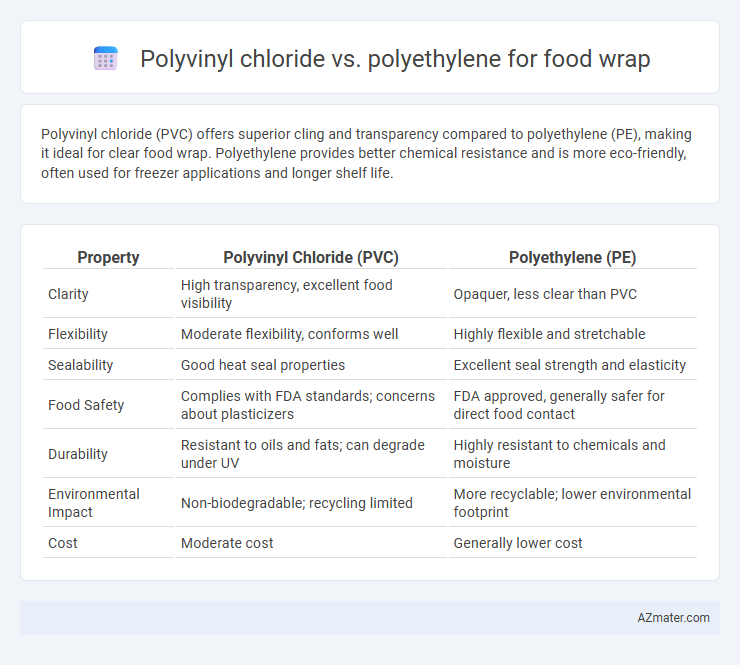Polyvinyl chloride (PVC) offers superior cling and transparency compared to polyethylene (PE), making it ideal for clear food wrap. Polyethylene provides better chemical resistance and is more eco-friendly, often used for freezer applications and longer shelf life.
Table of Comparison
| Property | Polyvinyl Chloride (PVC) | Polyethylene (PE) |
|---|---|---|
| Clarity | High transparency, excellent food visibility | Opaquer, less clear than PVC |
| Flexibility | Moderate flexibility, conforms well | Highly flexible and stretchable |
| Sealability | Good heat seal properties | Excellent seal strength and elasticity |
| Food Safety | Complies with FDA standards; concerns about plasticizers | FDA approved, generally safer for direct food contact |
| Durability | Resistant to oils and fats; can degrade under UV | Highly resistant to chemicals and moisture |
| Environmental Impact | Non-biodegradable; recycling limited | More recyclable; lower environmental footprint |
| Cost | Moderate cost | Generally lower cost |
Introduction to Food Wrap Materials
Polyvinyl chloride (PVC) and polyethylene (PE) are two primary materials used in food wrap production, each offering unique barrier properties and flexibility. PVC provides excellent cling and transparency, making it ideal for tightly sealing moist or fatty foods, while polyethylene is favored for its chemical inertness and better resistance to oils and acids. Understanding the differences in permeability, stretchability, and food safety compliance is essential for selecting the right wrap based on the specific food preservation needs.
Overview of Polyvinyl Chloride (PVC)
Polyvinyl chloride (PVC) is a widely used polymer in food wrap applications due to its excellent clarity, flexibility, and strong barrier properties against oxygen and moisture, which help preserve food freshness. PVC food wraps often contain plasticizers like phthalates to enhance stretchability and cling, though concerns about chemical migration have prompted the development of safer formulations. Its robust sealing ability and cost-effectiveness make PVC a popular choice compared to other materials, despite growing competition from polyethylene variants with improved safety profiles.
Overview of Polyethylene (PE)
Polyethylene (PE) is a widely used polymer in food wrap applications due to its excellent chemical resistance and flexibility, making it ideal for preserving freshness and preventing contamination. Its non-toxic and moisture-resistant properties ensure safe contact with various food items, contributing to extended shelf life without compromising quality. Compared to Polyvinyl Chloride (PVC), PE offers superior environmental stability and is easier to recycle, positioning it as a more sustainable choice for food packaging solutions.
Chemical Composition and Properties
Polyvinyl chloride (PVC) is a chlorinated polymer with a rigid carbon backbone containing chlorine atoms, providing it with excellent clarity and strong barrier properties against gases and moisture, making it ideal for food wrap applications. Polyethylene (PE), composed of long chains of ethylene monomers forming a non-polar hydrocarbon structure, offers greater flexibility, chemical resistance, and is less prone to leaching, which enhances its safety for direct food contact. The distinct chemical compositions result in PVC having superior cling and stretch qualities, while PE excels in durability and inertness, influencing their respective performance in food packaging.
Clarity and Visual Appeal
Polyvinyl chloride (PVC) offers superior clarity and gloss, making it ideal for food wrap applications that require high visual appeal and product visibility. Polyethylene (PE), while more flexible and less prone to tearing, typically has a hazier appearance and lower transparency compared to PVC. For packaging where clear presentation and consumer appeal are critical, PVC is often favored over PE despite its environmental concerns.
Flexibility and Stretchability
Polyvinyl chloride (PVC) offers superior stretchability and clings tightly to food containers, making it ideal for sealing irregular shapes and preserving freshness. Polyethylene (PE), especially low-density polyethylene, provides greater flexibility and is less prone to tearing, enhancing ease of use for wrapping bulky or oddly shaped items. Choosing between PVC and PE depends on the specific food wrapping needs where PVC excels in cling performance, while PE is preferred for durability and flexibility.
Barrier Properties: Oxygen, Moisture, and Aroma
Polyvinyl chloride (PVC) offers superior oxygen barrier properties compared to polyethylene (PE), making it more effective for preserving food freshness by limiting oxidative spoilage. PE exhibits better moisture barrier characteristics, providing enhanced protection against water vapor transmission and maintaining food texture and quality. In terms of aroma retention, PVC generally performs better due to its tighter molecular structure, which reduces odor transfer and helps preserve the original flavor of wrapped foods.
Safety and Food Contact Regulations
Polyvinyl chloride (PVC) and polyethylene (PE) are widely used materials for food wrap, with polyethylene generally considered safer due to its inert chemical properties and compliance with major food contact regulations such as FDA 21 CFR 177.1520. PVC often requires plasticizers like phthalates, which may migrate into foods, leading to stricter regulatory scrutiny and usage restrictions in sensitive applications. Food industry standards recommend polyethylene for direct food contact to minimize potential chemical migration and ensure consumer safety.
Environmental Impact and Recyclability
Polyvinyl chloride (PVC) food wrap poses significant environmental concerns due to its production involving chlorine, which can release toxic dioxins and complicate recycling processes. Polyethylene (PE) food wrap, typically low-density polyethylene (LDPE), offers better recyclability and lower environmental toxicity, as it is chlorine-free and more widely accepted in recycling streams. Choosing PE over PVC for food wrap reduces ecological harm and supports a more circular plastic economy.
Cost Comparison and Market Availability
Polyvinyl chloride (PVC) food wrap typically incurs higher production costs compared to polyethylene (PE) wrap due to its complex polymer structure and added plasticizers. Polyethylene food wrap dominates the market with widespread availability and lower pricing, driven by its simpler manufacturing process and higher consumer demand. Cost efficiency and broad distribution networks make polyethylene the preferred choice for food packaging in retail and commercial sectors.

Infographic: Polyvinyl chloride vs Polyethylene for Food Wrap
 azmater.com
azmater.com